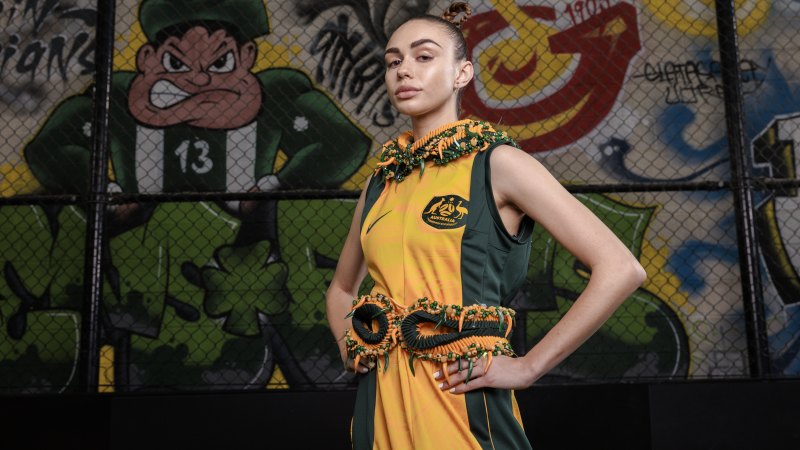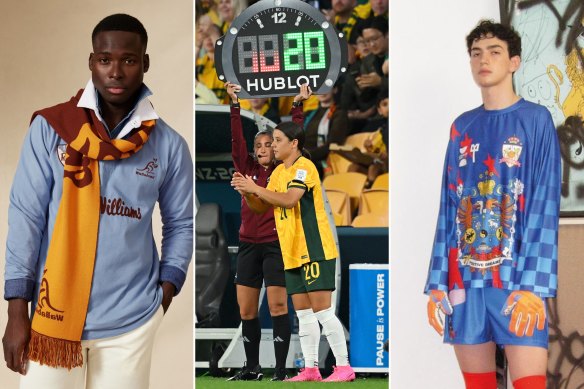Save articles for later
Add articles to your saved list and come back to them any time.
Sporting organisations are looking beyond acrylic knit budget beanies and scarves to target fans who spend their Saturdays queuing outside Gucci stores instead of screaming at umpires.
With World Cup merchandise sales soaring, English Premier League soccer clubs, the Olympics and Rugby Australia are upgrading their fashion merchandise to appeal to half-time shoppers who care as much about labels as they do their team colours.
“Sport and fashion have never been more connected,” says Nick Atkinson, Nike brand director. “This global football moment is creating platforms and opportunity far beyond just the players on the pitch.”
Matildas team jerseys had been outselling the 2019 releases 13 to one, before Wednesday night’s loss to England. To magnify the moment, Nike enlisted emerging design talent, including Australian Fashion Week success stories Alix Higgins and Grace Lillian Lee, to reimagine jerseys for the runway in a collection of one-off pieces dubbed Kit Couture.
“We felt it was essential to showcase the incredible young creative talent this country has to offer to the world,” Atkinson says.
The capital of fashion is taking things further, with luxury conglomerate LVMH last month named a premium partner of the 2024 Paris Olympic Games.
Heritage jeweller Chaumet will take a break from designing tiaras to create gold medals, beauty outlet Sephora will infiltrate crowds along the torch relay and fashion houses Dior, Berluti and Louis Vuitton will work directly with athletes on pieces, which could then make their way to the shop floor.
“Sports is a tremendous source of inspiration for our maisons, which will unite creative excellence and athletic performance by contributing their savoir-faire and bold innovation to this extraordinary celebration,” Bernard Arnault, chairman of LVMH, said in the announcement.
LVMH-owned watch brand Hublot has laid the groundwork for the Olympics team. Hublot partnered with FIFA in 2009 as their official timekeeper, and introduced a scoreboard shaped like a watch to the 2014 World Cup in Brazil.
“It’s about building brand awareness,” says Ricardo Guadalupe, Hublot chief executive. “You still have to be wealthy to buy a Hublot watch. It’s more about the teenager who looks at Hublot and thinks that the brand is cool.”
The RM Williams heritage pieces for Rugby Australia; Sam Kerr of on the touch line beneath the Hublot scoreboard during the FIFA Women’s World Cup Australia & New Zealand at Brisbane Stadium on August 12; the Leagues Cup merchandise from Liberal ministry of Youth and creative director Guillermo Andande.
Rugby Australia partnered with RM Williams in September looking for more immediate results. A capsule collection of heritage-inspired jerseys was released before last month’s Bledisloe Cup in Melbourne.
“To be in and around Melbourne when the Bledisloe was on and to see the jerseys in the crowd was incredible for the RM Williams community and the Wallabies community,” says Daniel Aldridge, special projects manager at RM Williams.
“We wanted a cohesive range that looked like a jersey but was also nostalgic and fashion forward. I wanted it to be accessible for a 16-year-old kid, up to his grandfather.”
For the merchandise makeover, Rugby Australia partnered with RM Williams but in the UK, sporting clubs are developing their own creative teams to explore fashion ranges and collaborations.
Designer turned consultant Kenny Annan-Jonathan was recently appointed the first creative director of an English Premier League club, signing with Crystal Palace.
It’s a move foreshadowed by streetwear brand Kith’s founder Ronnie Fieg becoming the first creative director of the New York Knicks, and Major League Soccer in the US hiring streetwear brand 424’s founder Guillermo Andrade as creative director of the Leagues Cup.
“These are all fashion guys who understand what it takes to build community through product, storytelling, through engagement and looking at new avenues and experiences,” says Annan-Thomas.
“The products clubs are trying to sell the most is training wear, which doesn’t mean anything to fans. It works for athletes, but you are expecting to see fans on a match day wear stuff that athletes wear to training. It doesn’t make any sense.”
“The way to engage with fans is to make them feel comfortable in what they are wearing. The sales have been drying up because there’s no new offering that allows them to be who they are.”
While collaborations can mean higher prices – a Leagues Cup polyester jersey overseen by Andrade with Liberal Youth Ministry start at $239 at e-boutique Farfetch – Annan-Johnston says clubs must also consider existing supporters.
“Just working with brands like Louis Vuitton and Supreme is only thinking about hype rather than creating an environment where fans can thrive,” Anna-Johnston says. “It would then be no different to the way luxury fashion took over streetwear.”
“We need to make the conversation exciting without pushing out the staple audience.”
Make the most of your health, relationships, fitness and nutrition with our Live Well newsletter. Get it in your inbox every Monday.
Most Viewed in Lifestyle
From our partners
Source: Read Full Article


